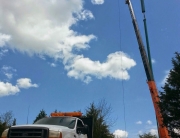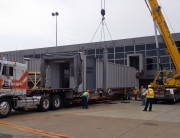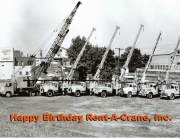Even though overhead crane and hoists are used for lifting heavy weights on construction sites, they both are pretty different from each other. People confuse these two in the area because of their similar functions, yet the distinct differences between their designs and processes cannot be denied.
It would help if you kept in mind that a crane is responsible for shifting the load up and down and side to side. At the same time, a hoist moves the loads up and down only. Both are used for lifting bulky materials at industrial or commercial construction sites, which gives rise to the never-ending confusion.
Buying a crane or a hoist for a construction project is not essential as it is quite an expensive investment. Instead, most people prefer to rent a crane if they don’t have to use it regularly for a long time. In case you want to rent one but are confused about whether you need an overhead crane or a hoist, we are here to help you.
Here is everything you need to know about overhead cranes and hoists, the differences, and the types.
Overhead Crane vs. Hoist
The basic purpose of cranes and hoists is to lift the weight, but there are differences between both that you must know before choosing any particular one to do the job. As mentioned above, one of the major differences between these is their range of movement. Hoists have a single vertical movement range, while cranes can move in two to three dimensions.
We can refer to an elevator as a hoist as it can only lift weight in a single plane or range of movement. Unlike cranes, the hoist mechanism in elevators is an exceptional example of lifting weight vertically. On the contrary, cranes can be moved in various directions. In the case of overhead cranes, they can also be suspended from moving along the rail or a beam.
Another major difference between overhead cranes and hoists is their categorization. At the same time, the major factors considered are their design and construction grouping of overhead cranes. Features like the gantry, top running, under running, and monorail are considered deliberately. But this is not the case with hoists as it is dependent on the lifting medium, suspension, and power type. You can get a crane from a VA crane rental company.
What are Overhead Cranes?
In case you are confused about cranes or hoists, we have enough information about each of them separately to clear their confusion. So, let’s start with a little overview of Overhead Cranes. An Overhead crane is a piece of equipment used to lift heavy weights, lower them down on a vertical axis, and move them along other axes.
Therefore, it can be said that cranes provide multi-directional mobility on construction sites. A crane can efficiently transfer load from one area to the other. For example, if you want to carry a heavy item from one part of the construction site to the other, you can’t do it yourself or ask the workers to do it. It is nearly impossible to do so, but a crane does the load transfer smoothly and efficiently.
Components of an Overhead Crane
There are three main components of the overhead crane, which are elaborated as follows;
Hoist – Any hoist equipment is responsible for the vertical lifting of the loads. A hoist in an overhead crane is connected to the trolley component, enabling it to move back and forth across the bridge.
Trolley – As mentioned above, the trolley is responsible for moving the hoist along the bridge when needed. It is available in three different types, which are explicitly designed for various particular situations.
Bridge – This is the component of the overhead crane on which the hoist moves.
Types of Overhead Cranes
There are various types of overhead cranes, including;
Top running cranes: In these cranes, the bridge components move on the top of ceiling-mounted rails. It is perfect for lifting heavy weights.
Under running cranes: Contrary to top running cranes, the bridge components in these cranes move on the bottom of the ceiling-mounted rails.
Gantry cranes: In these rails, the bridge component is not connected to the rail. A single or double girder is attached to the wheel legs in Gantry cranes, making it perfect for shipbuilding applications.
Monorail cranes: In the case of monorail cranes, the trolley-mounted hoist moves in an oval, circular, single, or winding path. These cranes are explicitly designed to carry loads in complex and tight spaces.
What are Hoists?
Hoists are the piece of equipment responsible for the vertical range of movement during the weight lifting. They can lift weight in any other direction or plane except when used as a lifting component of equipment like overhead cranes.
One of the most common examples of hoists is a lift or an elevator. Unlike overhead cranes, they are not categorized into types but are differentiated with the help of their designs.
Designs of Hoists
Various design considerations of hoists are listed below;
Lifting Medium – The material is used to connect the load hook and hoist’s body. The material type depends on the loads the hoist will be lifting. Some examples of lifting mediums include metal cable, rope, welded link chain, or roller load chain.
Power – This refers to how the hoist is powered, such as with a pulley, electrical, or pneumatic mechanism. This is completely dependent on the setup of the facility and the required lifting or lowering force.
Suspension – It is the mounting method of the hoist. Some of the most common mounting methods include trolley-mounted, hook-mounted, and lug-mounted. It is also dependent on the lifting requirements.
Final Words
Lifting is an integral process on any construction site, whether commercial, residential, or industrial. Overhead cranes and hoists are equipped to aid in the lifting process on the site. Even though they have similar functions and are confused as similar equipment, they have their differences.
The visible difference can be the range of movement, but this is not as mentioned in the information article above. Therefore, before contacting a rough terrain crane rental company, you must study these differences to know what equipment you need.





